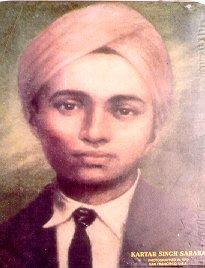Kartar Singh Sarabha
Kartar Singh Sarabha began his involvement in the Gadar Party in San Francisco in 1912. Sarabha was born in India in the year 1896. After his graduation from high school in 1911, he arrived at the University of California- Berkeley to continue his studies in engineering. In Berkeley, he joined the Gadar party in 1913. Around this time, he also learned how to fly. He returned to India in 1914 to fight for his country's independence. On November 16th, 1915, Sarabha was hanged at the tender age of 19.
Early life
Sarabha was born into a Grewal Jat Sikh family at village Sarabha in the district of Ludhiana, Punjab in 1896. His father's name was Sardar Mangal Singh. When he was fifteen, his parents put him on board a ship for America to work there. The ship landed at the American port of San Francisco in January 1912. The American Immigration officer put Indians through rigorous questioning while people of other countries were allowed to pass after slight checks. Kartar Singh asked one of the passengers about this type of behavior. He told him, "Indians are the citizens of a slave country. As such, they are treated badly." This incident had a great effect on Sarabha.
In 1914, Indians worked in foreign countries either as indentured labourers or soldiers fighting for the consolidation of British rule or extending the boundaries of the British Empire. Kartar enrolled at the University of California at Berekely(UCB) and also took up the work of picking fruit in orchards. He frequently talked to other Indians about getting his country freed.
The Ghadar Party and Newspaper
On April 21,1913, the Indians of California assembled and formed the Ghadar Party (Revolution Party). The aim of the Ghadar Party was to get rid of the slavery of the British by means of an armed struggle and set up a national democratic government. Their slogan was "Put at stake everything for the freedom of the country." On the November 1, 1913, the Ghadar Party started printing a paper named 'Ghadar', which was published in the Punjabi, Hindi, Urdu, Bengali, Gujarati and Pushto languages. Kartar Singh did all the work for that paper.
This paper was sent to Indians living in all countries throughout the world. The purpose of the paper was to unmask the truth about British rule to Indians, impart military training, and explain in details the methods of making and using weapons and explosives.
Within a short time, the Ghadar Party became very famous through its organ: 'The Ghadar". It drew Indians from all walks of life.
Revolt in the Punjab
With the start of World War I in 1914, the British became thoroughly engrossed in the war effort. Thinking it to be a good opportunity, the leaders of the Ghadar Party published the "Decision of Declaration of War" against the British in issue of 'The Ghadar' dated August 5, 1914. Thousands of copies of the paper were distributed among army cantonments, villages and cities. Kartar Singh reached Calcutta via Colombo on board SS Salamin, in November, 1914: he accompanied two other Gadhar leaders, Satyen Sen and Vishnu Ganesh Pingle, along with a large number of Gadhar militants. With a letter of introduction from Jatin Mukherjee,the Jugantar leader, Kartar Singh and Pingle met Rasbehari Bose at Benares to inform him that twenty thousand more Gadhar members were expected very soon [1]. A large number of leaders of the Ghadar Party were arrested by the Government at the ports. In spite of these arrests, a meeting was held by members of the Ghadar Party at Ladhouwal near Ludhiana in which it was decided to commit robberies in the houses of the rich to meet requirements of finance for armed action. Two Ghadris, Waryam Singh and Bhai Ram Rakha were killed in a bomb blast in one such raid.
After the arrival of Rash Behari Bose at Amritsar on January 25, 1915, it was decided on a meeting on February 12 that the uprising should be started on February 21. It was planned that after capturing the cantonments of Mian Mir and Ferozepur, mutiny was to be engineered near Ambala and Delhi.
Betrayal
Kirpal Singh, a police informer ('mole') in the ranks of the Ghadar Party had a large number of members arrested on February 19 and informed the Government of the planned revolt. The Government disarmed the native soldiers due to which the revolt failed.
On March 2, 1915, Risaldar Ganda Singh had Kartar Singh, Harman Singh, Tundilat, and Jagit Singh, arrested from Chakk, No. 5, district Lyallpur.
Verdict and Execution
The judgement in respect of 63 arrested Gadharites was pronounced on September 13, 1915 at the Central Jail, Lahore. In this first conspiracy case of 1914/15 AD, 24 Gadarites were sentenced to death. Kartar Singh was one of them.
The court observed that Kartar Singh was the most dangerous of all the rebels. "He is very proud of the crimes committed by him. He does not deserve mercy and should be sentenced to death". Kartar Singh was hanged in the Central Jail of Lahore on November 16, 1915, when he was only 18.

